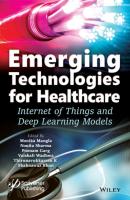Emerging Technologies for Healthcare. Группа авторов
Чтение книги онлайн.

Читать онлайн книгу Emerging Technologies for Healthcare - Группа авторов страница 3
Название: Emerging Technologies for Healthcare
Автор: Группа авторов
Издательство: John Wiley & Sons Limited
Жанр: Программы
isbn: 9781119792321
isbn:
List of Illustrations
1 Chapter 1Figure 1.1 Stages of IoT.Figure 1.2 Global market growth.
2 Chapter 2Figure 2.1 Process flow of smart healthcare application.Figure 2.2 Architecture of IoT-based SHCS [20].Figure 2.3 Layers of IoT on local server and on cloud server.Figure 2.4 System architect of smart healthcare system.Figure 2.5 Arduino UNO model [44].Figure 2.6 Smart healthcare system with its dimensions.Figure 2.7 Activation model for deep learning.Figure 2.8 Different deep neural network architectures for biomedical engineerin...
3 Chapter 3Figure 3.1 Machine learning end-to-end process for continuous delivery of ML mod...Figure 3.2 (a) The model visualization plot. (b) Confusion matrix after evaluati...Figure 3.3 The model visualization plot showing dropout and gaussian noise layer...Figure 3.4 Path integrals (a) classical mechanics case. (b) Path integrals showi...Figure 3.5 A Sample QLattice QGraph model for diabetes prediction.Figure 3.6 The best QGraph model extracted for the given diabetes prediction pro...Figure 3.7 The performance plots for the QGraph models. (a) Confusion matrix; (b...Figure 3.8 COVID-19 data plot (actual figures scaled by100,000 on Y-axis).Figure 3.9 Best QGraph model for the COVID-19 global deaths prediction.Figure 3.10 Plot for actual data of global deaths vs. predicted global deaths (r...Figure 3.11 Plot for actual data of COVID-19 pandemic vs. predicted global death...
4 Chapter 4Figure 4.1 How WBSN/WMIOT/WBAN, etc., work? [4].Figure 4.2 Various types of security and privacy needs for WBANs, WMSNs, WMIOTs,...Figure 4.3 KP-ABE and CP-ABE schemes in cloud computing and storage [20].Figure 4.4 Biomedical security system with blockchain [22].
5 Chapter 5Figure 5.1 Proposed methodology.Figure 5.2 Data collection key points.Figure 5.3 Representation of issues resolved by data preparation.Figure 5.4 Different classifiers.Figure 5.5 KNN algorithm.Figure 5.6 SVM classifier.Figure 5.7 Random Forest classifier.Figure 5.8 Graph of sigmoid function.Figure 5.9 Logistic classifier.Figure 5.10 User interaction model.Figure 5.11 System implementation.Figure 5.12 Dataset for model having no null values.Figure 5.13 Dataset for model implementation.Figure 5.14 Data splitter module.Figure 5.15 Building Random Forest model.Figure 5.16 Accuracy score of Random Forest classifier.Figure 5.17 Evaluation metrics of Random Forest classifier.Figure 5.18 Performance of Decision Tree classifier.Figure 5.19 Evaluation metrics of Decision Tree classifier.Figure 5.20 Performance of SVM classifier.Figure 5.21 Evaluation metrics of SVM classifier.
6 Chapter 6Figure 6.1 Proposed methodology.Figure 6.2 Flow chart for preparing 3D CNN.Figure 6.3 Max pooling.Figure 6.4 Flattening.Figure 6.5 Basic flow for system implementation.Figure 6.6 Code snippet for data pre-processing.Figure 6.7 Results of data pre-processing.Figure 6.8 Density of common substances on CT.Figure 6.9 Distinguishing between pixels and air.Figure 6.10 Bone structure.Figure 6.11 Segment lungs.Figure 6.12 Inner lungs structure.Figure 6.13 Code snippet for training and testing the dataset.Figure 6.14 Training results.Figure 6.15 Final output.
7 Chapter 7Figure 7.1 Proposed methodology.Figure 7.2 Different libraries employed for development of proposed model.Figure 7.3 CNN layers.Figure 7.4 CNN basic flow.Figure 7.5 ANN training.Figure 7.6 ANN working algorithms.Figure 7.7 System implementation.Figure 7.8 Code snippet for data pre-processing.Figure 7.9 Data split.Figure 7.10 Model training.Figure 7.11 Model fitting.Figure 7.12 Accuracy curve.Figure 7.13 Loss curve.Figure 7.14 Accuracy and precision matrix.
8 Chapter 8Figure 8.1 Polygonization [11].Figure 8.2 Thresholding [6].Figure 8.3 Binarization [24].Figure 8.4 Gray scaling [10].Figure 8.5 Noise reduction [10].Figure 8.6 Image inversion [10].Figure 8.7 Image dilation [10].Figure 8.8 Division of the image into zones [11].Figure 8.9 Zones detected in handwritten text [5].Figure 8.10 Word detection using contours [5].Figure 8.11 Detected enclosed space using Hough circle transform [5].Figure 8.12 The perceptron network [8].Figure 8.13 Artificial neural network [12].Figure 8.14 System architecture [13].Figure 8.15 System flow [14].Figure 8.16 Flowchart for personality prediction [15].Figure 8.17 Graph of the algorithm used for personality analysis versus its accu...Figure 8.18 Writer identification framework [18].Figure 8.19 Writer identification with a machine learning algorithm [25].
9 Chapter 9Figure 9.1 Steps for data acquisition and processing.Figure 9.2 Proposed system for risk mitigation in ASD individuals.Figure 9.3 Activations in parietal, temporal, and frontal regions showing decrea...Figure 9.4 Activations in frontal and temporal lobes showing reduced activity fo...Figure 9.5 sLORETA images of young individuals showing increase in activity in f...Figure 9.6 sLORETA images of young patients showing increase in activity in fron...
10 Chapter 10Figure 10.1 Machine learning ecosystem.Figure 10.2 Supervised and unsupervised learning models.Figure 10.3 Classification process.Figure 10.4 Decision tree example.
11 Chapter 11Figure 11.1 Factors modeled in risk-perception model.Figure 11.2 Schematic representation of the modeled parameters.Figure 11.3 Flowchart representing the weight up-gradation in risk assessment.
12 Chapter 12Figure 12.1 Importing of Pandas and Matplotlib and displaying the dataset.Figure 12.2 Bar graph of the dataset using the Seaborn Library.Figure 12.3 Replacing usernames and punctuations.Figure 12.4 Using common words and tokenizing.Figure 12.5 Using stemming and lemmatization.Figure 12.6 Using Bag of Words and TF-IDF count vectorizer and splitting the tra...Figure 12.7 Calculating result using accuracy score and f1 score.Figure 12.8 Architecture of random forest.
13 Chapter 13Figure 13.1 Correlation between COVID-19 new cases and stringency index.Figure 13.2 Proposed modules to build analyzer.Figure 13.3 Working flow of OpenCV.Figure 13.4 Basic architecture of TensorFlow.Figure 13.5 Sub-modules of person detection module.Figure 13.6 Bounding box with centroid point.Figure 13.7 System implementation.Figure 13.8 Work flow of proposed model.Figure 13.9 Annotated file JSON representation.Figure 13.10 Code snippet for frame creation.Figure 13.11 Code snippet for contour detection.Figure 13.12 TensorFlow workflow for model training.Figure 13.13 Code snippet for COCO model comparison.Figure 13.14 Code snippet for printing predictions.Figure 13.15 Final model.
14 Chapter 14Figure 14.1 Steps of IoT solution [15].Figure 14.2 IoT-enabled VAS system.Figure 14.3 Block diagram of the smart healthcare system.Figure 14.4 Architecture of the VAS ecosystem.
15 Chapter 15Figure 15.1 Bone repairing process [15].Figure 15.2 Bone substitute.Figure 15.3 Methodology of work.Figure 15.4 MRI to 3D model [6, 11].Figure 15.5 Process of additive manufacturing [11].Figure 15.6 Stereo-lithography [20].Figure 15.7 Fused deposition modeling [17].Figure 15.8 Schematic diagram of SLS [5, 24].Figure 15.9 Direct 3D printing [8].
List of Tables
1 Chapter 2Table 2.1 List of mobile apps and online sites for smart healthcare system.Table 2.2 List of wearables commercially available for health monitoring.Table 2.3 Deep learning models for bioinformatics.СКАЧАТЬ